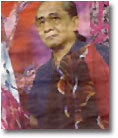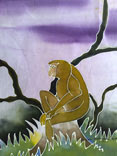 Dengue Fever, Symptom, Cure and How to Prevent It.
Dengue Fever, Symptom, Cure and How to Prevent It.
Dengue can bring fatal to someone who had been beaten by a mosquito which carry the virus call dengue. This tiny mosquito call Aedes aegypti can bring harm to human when it feeding off with human host. All Tamparuli citizen are advice to clean up their house area and always listen the health department on how to handle this problem. Dengue cases in Tamparuli is not high compare with other places but this kind of sickness can bring fatal to human and I think that precaution is better than cure. Please study this article and try to save more live to bring more happiness to the public.
Dengue fever
Dengue fever and dengue hemorrhagic fever (DHF) are acute febrile diseases transmitted by mosquitoes, which occur in the tropics, can be life-threatening, and are caused by four closely related virus serotypes of the genus Flavivirus, family Flaviviridae. It was identified and named in 1779. It is also known as breakbone fever, since it can be extremely painful. Unlike malaria, dengue is just as prevalent in the urban districts of its range as in rural areas. Each serotype is sufficiently different that there is no cross-protection and epidemics caused by multiple serotypes (hyperendemicity) can occur. Dengue is transmitted to humans by the Aedes (Stegomyia) aegypti or more rarely the Aedes albopictus mosquito. The mosquitoes that spread dengue usually bite at dusk and dawn but may bite at any time during the day, especially indoors, in shady areas, or when the weather is cloudy.
The WHO says some 2.5 billion people, two fifths of the world's population, are now at risk from dengue and estimates that there may be 50 million cases of dengue infection worldwide every year. The disease is now endemic in more than 100 countries.
Signs and symptoms
The disease manifests as fever of sudden onset associated with headache, muscle and joint pains (myalgias and arthralgias—severe pain that gives it the nickname break-bone fever or bonecrusher disease), distinctive retro-orbital pain, and rash.
The classic dengue rash is a generalised maculopapular rash with islands of sparing. A hemorrhagic rash of characteristically bright red pinpoint spots, known as petechiae can occur later during the illness and is associated with thrombocytopenia. It usually appears first on the lower limbs and the chest; in some patients, it spreads to cover most of the body. There may also be severe retro-orbital pain, (a pain from behind the eyes that is distinctive to Dengue infections), and gastritis with some combination of associated abdominal pain, nausea, vomiting coffee-grounds-like congealed blood, or severe diarrhea.
Some cases develop much milder symptoms which can be misdiagnosed as influenza or other viral infection when no rash or retro-orbital pain is present. Febrile travelers from tropical areas may transmit dengue inadvertently to previously Dengue free populations of Aedes (Stegomyia) aegypti mosquitoes, having not been properly diagnosed for Dengue. Patients only transmit Dengue when they are febrile and bitten by Aedes (Stegomyia) aegypti mosquitoes, or (much more unusually) via blood products.
The classic dengue fever lasts about two to seven days, with a smaller peak of fever at the trailing end of the disease (the so-called "biphasic pattern"). Recovery may be associated with prolonged fatigue and depression.Clinically, the platelet count will drop until after the patient's temperature is normal.Cases of DHF also show higher fever, variable hemorrhagic phenomena including bleeding from the eyes, nose, mouth, ear, into the gut, and oozing of blood from skin pores, thrombocytopenia, and hemoconcentration. When Dengue infections proceed to DHF symptoms, DHF causes vascular leak syndrome which includes fluid in the blood vessels leaking through the skin and into spaces around the lungs and abdomen. This fluid loss and severe bleeding can cause blood pressure to fall; then Dengue Shock Syndrome (DSS) sets in, which has a high mortality rate.
Neurological manifestations such as encephalitis may also occur .
Virology
The mosquito Aedes aegypti feeding off a human host
Dengue fever is caused by Dengue virus (DENV), a mosquito-borne flavivirus. DENV is an ssRNA positive-strand virus of the family Flaviviridae; genus Flavivirus. There are four serotypes of DENV. The virus has a genome of about 11000 bases that codes for three structural proteins, C, prM, E; seven nonstructural proteins, NS1, NS2a, NS2b, NS3, NS4a, NS4b, NS5; and short non-coding regions on both the 5' and 3' ends.
E protein
The DENV E (envelope) protein, found on the viral surface, is important in the initial attachment of the viral particle to the host cell. Several molecules which interact with the viral E protein (ICAM3-grabbing non-integrin.,CD209 , Rab 5 , GRP 78 , and The Mannose Receptor have been shown to be important factors mediating attachment and viral entry.
M protein
The DENV prM (membrane) protein, which is important in the formation and maturation of the viral particle, consists of seven antiparallel β-strands stabilized by three disulphide bonds.The glycoprotein shell of the mature DENV virion consists of 180 copies each of the E protein and M protein. The immature virion starts out with the E and prM proteins forming 90 heterodimers that give a spiky exterior to the viral particle. This immature viral particle buds into the endoplasmic reticulum and eventually travels via the secretory pathway to the golgi apparatus. As the virion passes through the trans-Golgi Network (TGN) it is exposed to low pH. This acidic environment causes a conformational change in the E protein which disassociates it from the pr M protein and causes it to form E homodimers. These homodimers lay flat against the viral surface giving the maturing virion a smooth appearance. During this maturation pr peptide is cleaved from the M peptide by the host protease, furin. The M protein then acts as a transmembrane protein under the E-protein shell of the mature virion. The pr peptide stays associated with the E protein until the viral particle is released into the extracellular environment. This pr peptide acts like a cap, covering the hydrophobic fusion loop of the E protein until the viral particle has exited the cell.
NS3 protein
The DENV NS3 is a serine protease, as well as an RNA helicase and RTPase/NTPase. The protease domain consists of six β-strands arranged into two β-barrels formed by residues 1-180 of the protein. The catalytic triad (His-51, Asp-75 and Ser-135), is found between these two β-barrels, and its activity is dependent on the presence of the NS2B cofactor. This cofactor wraps around the NS3 protease domain and becomes part of the active site. The
remaining NS3 residues (180-618), form the three subdomains of the DENV helicase. A six stranded parallel β-sheet surrounded by four α-helices make up subdomains I and II, and subdomain III is composed of 4 α-helices surrounded by three shorter α-helices and two antiparallel β-strands.
NS5 protein
The DENV NS5 protein is a 900 residue peptide with a methyltransferase domain at its N-terminal end (residues 1-296) and a RNA-dependent RNA polymerase (RdRp) at its C-terminal end (residues 320–900). The nontransferable domain consists of an α/β/β sandwich flanked by N-and C-terminal subdomains. The DENV RdRp is similar to other Rd Rps containing palm, finger, and thumb subdomains and a GDD motif for incorporating nucleotides The potential factors causing hemorrhagic fever are varied. The most suspected factors are human's cross-serotypic immune response and membrane fusion process.Human antibodies produced in response to the virus actually increase the infection.
Diagnosis
The diagnosis of dengue is usually made clinically. The classic picture is high fever with no localising source of infection, a rash with thrombocytopenia and relative leukopenia - low platelet and white blood cell count. Dengue infection can affect many organs and thus may present unusually as liver dysfunction, renal impairment, meningo-encephalitis or gastroenteritis.Fever, headaches, eye pain, severe dizziness and loss of appetite.Hemorrhagic tendency (positive tourniquet test, spontaneous bruising, bleeding from mucosa, gingiva, injection sites, etc.; vomiting blood, or bloody diarrhea)Thrombocytopenia (<100,000>Evidence of plasma leakage (hematocrit more than 20% higher than expected, or drop in hematocrit of 20% or more from baseline following IV fluid, pleural effusion, ascites, hypoproteinemia)
Encephalitic occurrences.
Dengue shock syndrome is defined as dengue hemorrhagic fever plus:
Weak rapid pulse,
Narrow pulse pressure (less than 20 mm Hg)
Cold, clammy skin and restlessness.
Dependable, immediate diagnosis of dengue can be performed in rural areas by the use of Rapid Diagnostic Test kits, which also differentiate between primary and secondary dengue infections.Serology and polymerase chain reaction
(PCR) studies are available to confirm the diagnosis of dengue if clinically indicated. Dengue can be a life threatening fever.
One test is called Platelia Dengue NS1 Ag assay, or NS1 antigen test for short, made by Bio-Rad Laboratories and Pasteur Institute, introduced in 2006, allows rapid detection before antibodies appear the first day of fever.In India, the diagnosis of dengue may take up to a week. The introduction of PCR (NS1) in September 2010 cut short the waiting time to 48 hours. It costs approximately 1,600 rupees.In many poverty stricken areas, a diagnosis may be too expensive and/or meaningless (given there is no cure, only supportive therapy) so significant under-reporting is expected to be the norm.
Prevention
There is no tested and approved vaccine for the dengue flavivirus. There are many ongoing vaccine development programs. Among them is the Pediatric Dengue Vaccine Initiative set up in 2003 with the aim of accelerating the development and introduction of dengue vaccine(s) that are affordable and accessible to poor children in endemic countries.Thai researchers are testing a dengue fever vaccine on 3,000–5,000 human volunteers after having successfully conducted tests on animals and a small group of human volunteers.A number of other vaccine candidates are entering phase I or II testing.As of July 2010, the National Institutes of Health reported on their Clinical Trials.Gov Web site that there were 11 vaccines undergoing testing or recruiting for participants.Because exposure to one of dengue's four serotypes provides no immunity against infection by the other types, and may make the patient susceptible to more severe disease symptoms, testing vaccines must be performed carefully, and usually not in areas where the disease is endemic for fear that even attenuated virus vaccines may cause severe reactions.In 1998, scientists from the Queensland Institute of Medical Research (QIMR) in Australia and Vietnam's Ministry of Health introduced a scheme that encouraged children to place a water bug, the crustacean Mesocyclops, in water tanks and discarded containers where the Aedes aegypti mosquito was known to thrive.This method is viewed as being more cost-effective and more environmentally friendly than pesticides, though not as effective, and requires the continuing participation of the community.Even though this method of mosquito control was successful in rural provinces, not much is known about how effective it could be if applied to cities and urban areas. The Mesocyclops can survive and breed in large water containers but would not be able to do so in small containers that most urban dwellers have in their homes. Also, Mesocyclops are hosts for the guinea worm, a pathogen that causes a parasite infection, and so this method of mosquito control cannot be used in countries that are still susceptible to the guinea worm. The biggest dilemma with Mesocyclops is that its success depends on the participation of the community. This idea of a possible parasite-bearing creature in household water containers dissuades people from continuing the process of inoculation and, without the support and work of everyone living in the city, this method will not be successful.
Treatment
The mainstay of treatment is timely supportive therapy to tackle circulatory shock due to hemoconcentration and bleeding. Close monitoring of vital signs in the critical period (up to 2 days after defervescence - the departure or subsiding of a fever) is critical. Oral rehydration therapy is recommended to prevent dehydration in moderate to severe cases. Supplementation with intravenous fluids may be necessary to prevent dehydration and significant concentration of the blood if the patient is unable to maintain oral intake. A platelet transfusion may be indicated if the platelet level drops significantly (below 20,000) or if there is significant bleeding. The presence of melena may indicate internal gastrointestinal bleeding requiring platelet and/or red blood cell transfusion.Aspirin and non-steroidal anti-inflammatory drugs should be avoided as these drugs may worsen the bleeding tendency associated with some of these infections. All kinds of Intramuscular injections are contraindicated. Patients may receive paracetamol, acetaminophen, preparations to deal with these symptoms if dengue is suspected.
* Be careful...... Happy Reading *
Story: Tamparuli Admin
Sources: Health Department of Malaysia and Wikipedia
Picture: Wikipedia
























































